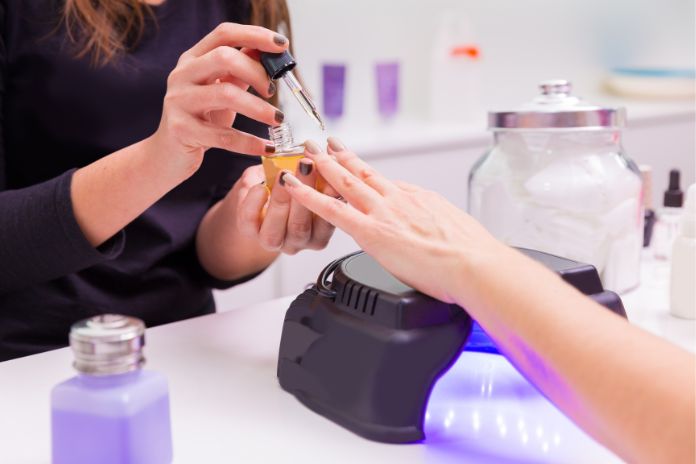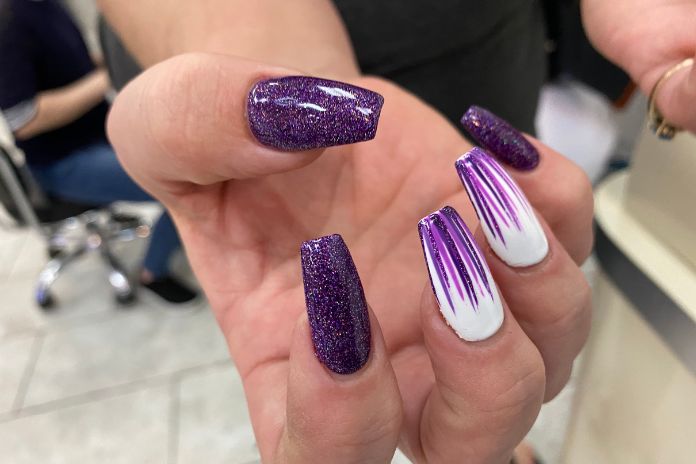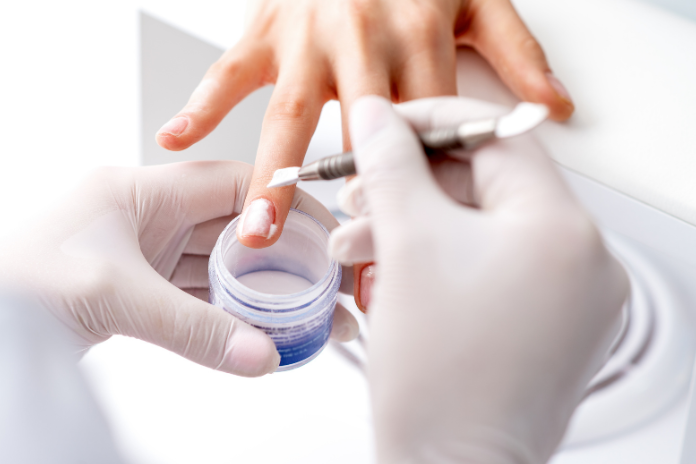Yes, You Can Put Acrylic Nails Over Fungus: Here’s What You Need to Know

Acrylic nails are a popular choice for those looking to enhance the appearance of their nails. However, if you have a fungal infection, you may be wondering if it’s safe to put acrylic nails over the affected area. Fungal infections can cause discoloration, thickening, and crumbling of the nails, and it’s important to take proper precautions to prevent further damage.
The short answer is no, you should not put acrylic nails over fungus. Doing so can trap moisture and create a breeding ground for the fungus to grow and spread. It’s essential to treat the underlying fungal infection first to avoid further damage to the nail and prevent the spread of the infection to other nails. There are several treatment options available, including topical and oral medications, laser therapy, and surgical removal of the nail in severe cases.
Contents
What is Nail Fungus?
Nail fungus, also known as onychomycosis, is a common fungal infection that affects the nails of both fingers and toes. It is caused by various types of fungi, including dermatophytes, yeasts, and molds.
Nail fungus is a contagious infection that can spread from one nail to another and from person to person. It is more common in people with weakened immune systems, diabetes, and circulation problems.
The symptoms of nail fungus include thickened, discolored, and brittle nails, as well as nail separation from the nail bed. In severe cases, the infected nail may emit a foul odor and cause pain or discomfort.
Nail fungus can be prevented by maintaining good hygiene, wearing breathable shoes, and avoiding sharing personal items such as nail clippers and socks. If left untreated, nail fungus can lead to more serious health issues, so it is important to seek medical attention if you suspect you have a fungal infection.
In summary, nail fungus is a common and contagious infection that affects the nails of both fingers and toes. It is caused by various types of fungi and can lead to serious health issues if left untreated.
Can You Put Acrylic Nails Over Fungus?
Acrylic nails are a popular choice for those who want to enhance the appearance of their natural nails. However, if you have a fungal nail infection, you may be wondering if it is safe to put acrylic nails over the affected nails. In this section, we will explore this question and provide you with some helpful information.
Artificial Nails and Fungal Nail Infection
Artificial nails, including acrylic nails, can be applied over a fungal nail infection. However, it is important to note that this may not be the best course of action. Applying artificial nails over a fungal nail infection can trap moisture and create a warm, dark environment that can promote the growth of fungus. This can lead to further infection and make it more difficult to treat the underlying fungal infection.
Treatment Options
If you have a fungal nail infection, it is important to seek treatment before considering applying acrylic nails. There are several treatment options available, including:
- Antifungal medications: These can be taken orally or applied topically to the affected nail.
- Laser therapy: This involves using a laser to heat and destroy the fungus.
- Surgical removal: In severe cases, the infected nail may need to be surgically removed.
It is important to speak with a healthcare professional to determine the best course of treatment for your specific situation.
Guide to Applying Acrylic Nails over Fungus
If you have received treatment for your fungal nail infection and have been cleared by a healthcare professional to apply acrylic nails, here are some tips to help you do so safely:
- Ensure the affected nail is completely dry before applying acrylic nails.
- Apply a primer to the affected nail to help prevent moisture from getting trapped under the acrylic nail.
- Use a high-quality acrylic nail kit and follow the instructions carefully.
- Avoid applying acrylic nails too frequently, as this can damage the natural nail and make it more susceptible to fungal infections.
Conclusion
While it is possible to apply acrylic nails over a fungal nail infection, it may not be the best course of action. It is important to seek treatment for the underlying fungal infection before considering applying artificial nails. If you do choose to apply acrylic nails, be sure to follow the tips above to do so safely.
Risks of Putting Acrylic Nails Over Fungus
Putting acrylic nails over fungus might seem like a quick fix to cover up unsightly toenails, but it comes with several risks. Acrylic nails can trap moisture, providing an ideal environment for bacteria and fungal infections to thrive. This can lead to more serious infections and complications.
One of the most common risks of putting acrylic nails over fungus is discoloration and brittleness of the nails. The acrylic material can worsen the underlying problem, making the nails more brittle and prone to breaking. This can be painful and may require medical attention.
Another risk is the potential for contaminated equipment or surfaces. If the tools used to apply the acrylic nails are not properly sterilized, they can spread infections or bacteria to other clients. Contaminated surfaces can also harbor bacteria and fungi, increasing the risk of infection.
It’s important to note that putting acrylic nails over fungus does not address the underlying problem. Fungal infections require proper treatment to prevent them from spreading or becoming more severe. In some cases, the fungus may be an indication of an underlying health condition that requires medical attention.
In summary, putting acrylic nails over fungus can lead to several risks and complications. It’s important to address any fungal infections properly and seek medical attention if necessary. Using clean and properly sterilized equipment is also crucial to prevent the spread of infections.
Treatment Options for Nail Fungus
Nail fungus, also known as onychomycosis, is a common condition that affects the nails of the fingers and toes. It is caused by a fungal infection that can make the nails thick, discolored, and brittle. If left untreated, nail fungus can cause pain and discomfort, and may even lead to permanent nail damage. Fortunately, there are several treatment options available for nail fungus.
Antifungal Medications
Antifungal medications are the most common treatment option for nail fungus. These medications work by killing the fungus that causes the infection. Some of the most commonly prescribed antifungal medications include terbinafine, itraconazole, and fluconazole. These medications are typically taken orally and can take several months to fully clear up the infection.
Topical Treatments
Topical treatments, such as Penlac, Efinaconazole, and Tavaborole, are applied directly to the affected nail. These medications work by penetrating the nail and killing the fungus. Topical treatments can take several months to fully clear up the infection, and may not be as effective as oral medications.
Prescription Medications
Prescription medications, such as Sporanox and Ciclopirox, are also available to treat nail fungus. These medications are typically prescribed by a dermatologist or podiatrist and are often used in combination with other treatments.
Home Remedies
There are several home remedies that can be used to treat nail fungus. These include applying tea tree oil, vinegar, or Vicks Vaporub to the affected nail. While these remedies may help to improve the appearance of the nail, they are not as effective as prescription medications.
Surgery
In severe cases of nail fungus, surgery may be necessary to remove the affected nail. This is typically only done if the infection is causing significant pain or discomfort.
Dermatologist or Podiatrist
If you suspect that you have nail fungus, it is important to see a dermatologist or podiatrist for diagnosis and treatment. These medical professionals can prescribe the appropriate medication and provide guidance on how to prevent the spread of the infection.
In conclusion, nail fungus is a common condition that can be effectively treated with a variety of options. Whether you choose to use antifungal medications, topical treatments, or home remedies, it is important to seek the advice of a medical professional to ensure that you are using the most effective treatment for your specific case of nail fungus.
Prevention of Nail Fungus
Preventing nail fungus is important for maintaining healthy nails. Here are a few tips to prevent nail fungus:
- Practice good nail care: Keep your nails clean and trimmed. Don’t share nail clippers or other nail tools with others.
- Sanitize nail tools: If you do share nail tools, make sure to sanitize them before and after use.
- Neutralize nail fungus: Use a vinegar foot soak to neutralize nail fungus. Mix equal parts of vinegar and water in a basin and soak your feet for 15 minutes.
- Let your feet breathe: Avoid wearing closed-toe shoes for extended periods of time. Wear breathable shoes and socks.
- Keep your feet dry: Moisture can lead to nail fungus. Dry your feet thoroughly after showering or swimming.
It’s important to note that individuals who are immunosuppressed or have psoriasis may be more susceptible to nail fungus. Additionally, some people may have an allergic reaction to the adhesive used for fake toenails or acrylic toenails. If you suspect you have nail fungus, it’s best to consult a dermatologist for treatment options.
Conclusion
In conclusion, it is not recommended to put acrylic nails over fungus. While it may temporarily disguise the appearance of the fungus, it will not aid in the healing process and may even make the condition worse.
Fungal infections can be unsightly and may cause embarrassment, but it is important to address the underlying issue rather than simply trying to cover it up. Signs of a fungal infection include thickened, discolored, or brittle nails, as well as separation of the nail from the nail bed.
If you suspect that you have a fungal infection, it is important to seek treatment from a healthcare professional. They can provide a diagnosis and recommend an appropriate course of treatment, which may include antifungal medication or other topical treatments.
In the meantime, it is important to keep the affected area clean and dry, and to avoid sharing nail clippers or other personal items that may spread the infection. With proper treatment and care, most fungal infections can be effectively treated and will eventually clear up.





